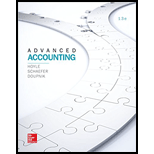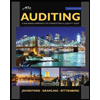
a.
Prepare schedules for acquisition-date fair-value allocations and amortizations for Company A’s investment in Company B.
a.
Explanation of Solution
Schedules for acquisition-date fair-value allocations and amortizations for Company A’s investment in Company B:
| Particulars | Amount | ||
| Consideration transferred by Company A | $ 603,000 | ||
| Fair value of non-controlling interest | $ 67,000 | ||
| Total fair value of Company B | $ 670,000 | ||
| Book value of Company B | $ (460,000) | ||
| Excess fair value over book value | $ 210,000 | ||
| Excess fair value allocated to: | Remaining life | Annual amortization | |
| Land | $ 30,000 | $ - | |
| Building | $ (20,000) | 10 years | $ (2,000) |
| Equipment | $ 40,000 | 5 years | $ 8,000 |
| Patent | $ 50,000 | 10 years | $ 5,000 |
| Notes Payable | $ 20,000 | 5 years | $ 4,000 |
| $ 90,000 | indefinite | $ - | |
| Total | $ 15,000 |
Table: (1)
b.
Determine the method of accounting of Company A’s investment in Company B.
b.
Explanation of Solution
Company A is using the partial equity method for its investment in Company B. Company A is earning income from investment in Company B which is 90% of the earnings of Company B from its assets.
Thus,
c.
Determine the balances to be reported as of December 31, 2018, for this business combination.
c.
Explanation of Solution
The balances to be reported as of December 31, 2018, for this business combination:
| Income statement | Company A | Company B | Consolidated Balances |
| Revenues | $ (940,000) | $ (280,000) | $ (1,220,000) |
| Cost of goods sold | $ 480,000 | $ 90,000 | $ 570,000 |
| | $ 100,000 | $ 55,000 | $ 161,000 |
| Amortization expense | $ - | $ 5,000 | |
| Interest expense | $ 40,000 | $ 15,000 | $ 59,000 |
| Equity in income of Company B | $ (108,000) | $ - | |
| Net income | $ (428,000) | $ (120,000) | |
| Consolidated net income | $ (425,000) | ||
| Share of non-controlling interest in net income | $ 10,500 | ||
| Share of controlling interest in net income | $ (414,500) | ||
| | |||
| Current assets | $ 610,000 | $ 250,000 | $ 860,000 |
| Equipment | $ 873,000 | $ 150,000 | $ 1,047,000 |
| Investment in Company B | $ 702,000 | $ - | $ - |
| Building | $ 490,000 | $ 250,000 | $ 724,000 |
| Patents | $ - | $ 40,000 | |
| Land | $ 380,000 | $ 150,000 | $ 560,000 |
| Goodwill | $ - | $ 90,000 | |
| Total assets | $ 3,055,000 | $ 800,000 | $ 3,321,000 |
| Notes payable | $ (860,000) | $ (230,000) | $ (1,078,000) |
| Common stock | $ (510,000) | $ (180,000) | $ (510,000) |
| | $ (1,685,000) | $ (390,000) | $ (1,658,000) |
| Non-controlling interest in Company S | $ (75,000) | ||
| Total liabilities and equity | $ (3,055,000) | $ (800,000) | $ (3,321,000) |
Table: (2)
Working note:
| Statement of retained earnings | Company A | Company B | Consolidated Balances |
| Retained earnings on 01/01 | $ (1,367,000) | $ (340,000) | $ (1,353,500) |
| Net Income | $ (428,000) | $ (120,000) | $ (414,500) |
| Dividends declared | $ 110,000 | $ 70,000 | $ 110,000 |
| Retained earnings on 31/12 | $ (1,685,000) | $ (390,000) | $ (1,658,000) |
Table: (3)
Computation of the amount to be allocated to investments:
Computation of the amount to be allocated to non-controlling interest:
d.
Prepare a consolidation worksheet for Company A and Company B, as of December 31, 2018.
d.
Explanation of Solution
The consolidation worksheet for Company A and Company B, as of December 31, 2018:
| Income statement | Company A | Company B | Debit | Credit | Non-controlling interest | Consolidated Balances |
| Revenues | $ (940,000) | $ (280,000) | $ (1,220,000) | |||
| Cost of goods sold | $ 480,000 | $ 90,000 | $ 570,000 | |||
| Depreciation expense | $ 100,000 | $ 55,000 | $ 161,000 | |||
| Amortization expense | $ - | E 80,000 | $ 5,000 | |||
| Interest expense | $ 40,000 | $ 15,000 | $ 59,000 | |||
| Equity in income of Company B | $ (108,000) | I 121,500 | $ - | |||
| Net income | $ (428,000) | $ (120,000) | ||||
| Consolidated net income | $ (425,000) | |||||
| Share of non-controlling interest in net income | $ (13,500) | $ 10,500 | ||||
| Share of controlling interest in net income | $ (414,500) | |||||
| Balance Sheet | ||||||
| Current assets | $ 610,000 | $ 250,000 | $ 860,000 | |||
| Equipment | $ 873,000 | $ 150,000 | D $32,000 | S 8,000 | $ 1,047,000 | |
| Investment in Company B | $ 702,000 | $ - | $ 63,000 | A $13,500 | $ - | |
| $ 468,000 | ||||||
| $ 175,500 | ||||||
| $ 108,000 | ||||||
| Building | $ 490,000 | $ 250,000 | $ 2,000 | I 18,000 | $ 724,000 | |
| Patents | $ - | E 10,000 | $ 40,000 | |||
| Land | $ 380,000 | $ 150,000 | $ 30,000 | $ 560,000 | ||
| Goodwill | $ - | $ 90,000 | $ 90,000 | |||
| Total assets | $ 3,055,000 | $ 800,000 | $ 3,321,000 | |||
| Notes payable | $ (860,000) | $ (230,000) | $ 16,000 | $ 4,000 | $ (1,078,000) | |
| Common stock | $ (510,000) | $ (180,000) | $ 180,000 | $ (510,000) | ||
| Retained earnings on 12/31 | $ (1,685,000) | $ (390,000) | $ 52,000 | $ (1,658,000) | ||
| Non-controlling interest in Company S | S $19,500 | $ (71,500) | $ (75,000) | |||
| Total liabilities and equity | $ (3,055,000) | $ (800,000) | $ (3,321,000) |
Table: (4)
Working note:
| Statement of retained earnings | Company A | Company B | Debit | Credit | Non-controlling interest | Consolidated Balances |
| Retained earnings on 01/01 | $ (1,367,000) | $ (340,000) | $ 13,500 | $ (1,353,500) | ||
| Net Income | $ (428,000) | $ (120,000) | $ (414,500) | |||
| Dividends declared | $ 110,000 | $ 70,000 | D 63,000 | D 7,000 | $ 110,000 | |
| Retained earnings on 31/12 | $ (1,685,000) | $ (390,000) | $ (1,658,000) |
Table: (5)
Want to see more full solutions like this?
Chapter 4 Solutions
Soft Bound Version for Advanced Accounting 13th Edition
- Lauren Industries uses a predetermined overhead rate based on direct labor cost to apply manufacturing overhead to jobs. Last year, the company's estimated manufacturing overhead was $2,400,000, and its estimated level of activity was 80,000 direct labor-hours. The company's direct labor wage rate is $18 per hour. Actual manufacturing overhead amounted to $2,320,000, with actual direct labor cost of $1,485,000. For the year, manufacturing overhead was_. Need answerarrow_forwardPlease explain the solution to this financial accounting problem with accurate principles.arrow_forwardCan you solve this general accounting problem using appropriate accounting principles?arrow_forward
- Please explain the solution to this general accounting problem with accurate principles.arrow_forwardCan you explain this general accounting question using accurate calculation methods?arrow_forwardI am searching for the correct answer to this general accounting problem with proper accounting rules.arrow_forward
- Hello tutor please given General accounting question answer do fast and properly explain all answerarrow_forwardCan you help me solve this general accounting problem with the correct methodology?arrow_forwardCan you help me solve this general accounting question using the correct accounting procedures?arrow_forward
 Financial AccountingAccountingISBN:9781305088436Author:Carl Warren, Jim Reeve, Jonathan DuchacPublisher:Cengage Learning
Financial AccountingAccountingISBN:9781305088436Author:Carl Warren, Jim Reeve, Jonathan DuchacPublisher:Cengage Learning Auditing: A Risk Based-Approach to Conducting a Q...AccountingISBN:9781305080577Author:Karla M Johnstone, Audrey A. Gramling, Larry E. RittenbergPublisher:South-Western College Pub
Auditing: A Risk Based-Approach to Conducting a Q...AccountingISBN:9781305080577Author:Karla M Johnstone, Audrey A. Gramling, Larry E. RittenbergPublisher:South-Western College Pub

